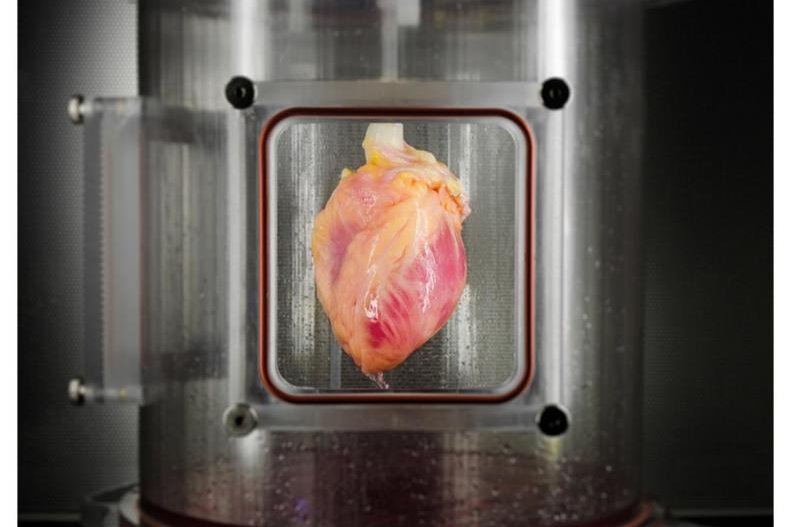A partially recellularized human whole-heart cardiac scaffold, reseeded with human cardiac cells derived from induced pluripotent stem cells, being cultured in a bioreactor that delivers a nutrient solution and replicates some of the environmental conditions around a living heart. Photo by Dr. Bernhard Jank/Massachusetts General Hospital
BOSTON, March 11 (UPI) -- Scientists grew functional heart tissue using donated hearts stripped of their cells, according to scientists at Harvard Medical School.
While growing an entire human heart is still far off, the scientists said tissue grown from a patient's own cells may lead to patches to replace cardiac tissue damaged during a heart attack.
Scientists at Harvard have spent several years developing a procedure to strip the living cells from a donor organ with a detergent solution. They've grown new tissue by seeding the extracellular matrix scaffolds left behind using organ-appropriate types of cells, including animal limbs and kidneys that were implanted in rats.
"Generating personalized functional myocardium from patient-derived cells is an important step towards novel device-engineering strategies and will potentially enable patient-specific disease modeling and therapeutic discovery," Dr. Harold Ott, an assistant professor of surgery at Harvard Medical School, said in a press release.
For the study, published in Circulation Research, the scientists obtained 73 human hearts donated for research because they could not be used for transplants. The hearts were decellularized, leaving only the scaffolds with matrix proteins, and coronary vascular and microvascular structures intact, but no cardiac or immune cells from the donor that could cause rejection or impede tissue growth.
The scientists used skin cells reprogrammed to be pluripotent cells that differentiate into cardiac muscle cells. These cells were then seeded into the stripped hearts for 120 days while the growing tissues were exposed to conditions similar to a living heart. As the tissue grew, it appeared to be developing the force-generating capability required of cardiac tissue when stimulated with electrical currents.
The next step for the scientists is to find ways to optimize culturing methods to generate a much higher number of cells -- recellularizing an entire heart requires tens of billions of cells. Methods to electronically integrate grown cardiac tissue into a patient's functioning heart also need to be optimized, the scientists said.
"Regenerating a whole heart is most certainly a long-term goal that is several years away, so we are currently working on engineering a functional myocardial patch that could replace cardiac tissue damaged due a heart attack or heart failure," said Dr. Jacques Guyette, a researcher in the Center for Regenerative Medicine at Massachusetts General Hospital.















